Advertisements
Advertisements
प्रश्न
When will be the growth of population positive in any place and in which one of the following conditions?
विकल्प
High birth rate, low death rate and high immigration.
High birth rate, high death rate and low immigration.
Low birth rate, high death rate and low immigration.
Low birth rate, low death rate and low immigration.
उत्तर
High birth rate, low death rate and high immigration.
Explanation:
Birth rates should outpace death rates in order to increase the population. Some of the following quaternary activities include information production, production, and dissemination.
APPEARS IN
संबंधित प्रश्न
With the help of suitable diagram describe the logistic population growth curve.
List any three important characteristics of a population and explain.
If 8 individuals in a population of 80 butterflies die in a week, calculate the death rate of the population of butterflies during that period.
What is ‘carrying capacity’ of a species in a habitat ? Why is logistic growth model considered more realistic?
Examine the following statement and correct the incorrect one.
Greater economic prosperity indicates the development of a region.
Examine the following statement and correct the incorrect one.
Developing countries have an HDI of 1.
Identify the correct correlation :
A: Assertion; R: Reasoning
A: In stage 2, the death rate reduces but the birth rate is constant.
R: The population increases rapidly in stage 2.
Give a geographical reason:
Population may increase though birth rates are low.
India’s population as per 2011 census is:
Which one of the following is not a push factor?
What are the three components of population change?
Birth rate and death rate.
Which country has the highest and lowest growth rate of the population respectively?
What is the impact of migration?
Distinguish between the place of origin and the place of destination.
Define the term ‘positive growth of population’.
Why do people migrate in large numbers from rural to urban areas in India?
The growth of population rate per decade is ______.
The continent that has the highest growth rate of population.
Which of the following is not a pull factor?
How many times the world population has increased during the last 500 years?
Which of these statements is not true?
Consider the following statements and choose the correct option from the given options:
1. Population grown rapidly during the sixteenth and seventeenth centuries.
2. Expansion of world trade during the sixteenth and seventeenth centuries is an important cause of it.

Which is not in stage III?
Study the given graph carefully and answer the following question:
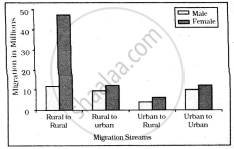
Intra-state Migration by place of Last Residence Indicating Migration Streams India, 2011
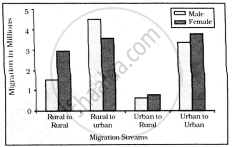
Inter-state Migration by Place of Last Residence Indicating Migration Streams India, 2011
Who dominates the intra-state migration of short distances?
Study the given graph carefully and answer the following question:

Intra-state Migration by place of Last Residence Indicating Migration Streams India, 2011

Inter-state Migration by Place of Last Residence Indicating Migration Streams India, 2011
Who dominates the inter-state migration of short distances?
On the basis of the demographic data of a country given below, construct an age pyramid and explain whether the population is stable, declining or growing.
| Age group | No. of individuals |
| Pre-reproductive | 20,000 |
| Reproductive | 15,000 |
| Post-reproductive | 10,000 |
Which of the following statement is true?
(i) CBR = Bi/P × 1000
(ii) COR = D /P × 1000
(iii) If birth rate is more than death rate, then CBR results in positive growth of population.
Which of the following pairs is not correctly matched?
Which of the following formula correctly depicts natural growth of population?
Which of the following forms the component of a nation?
What would be the per cent growth or birth rate per individual per hour for the same population mentioned in the previous question (Question 10)?
What would be the growth rate pattern, when the resources are unlimited?
Comment on the growth curve given below.
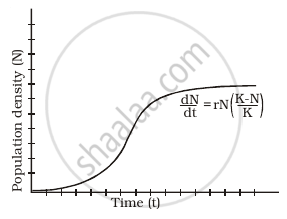
Which of the following may be interpreted as a spontaneous effort to achieve a better balance between population and resources?
"Migration may be interpreted as a spontaneous effort to achieve a better balance between population and resources." Examine the statement in context of pull and push factors that influence migration.
Examine the different aspects of the growth of population in India during 1951-1981 and 1981-2021.
Assertion (A): Population of a region does not change.
Reasoning (R): Birth rate, death rate and migration affect the population of a region.
Assertion (A): Population of a region does not change.
Reasoning (R): Birth rate, death rate and migration affect the population of a region.
A : Population of a region does not change.
R : Birth rate, death rate and migration affect the population of a region.
A: The population of a region does not change.
R: Birth rate, death rate and migration affect the population of a region.
Assertion (A): Population of a region does not change.
Reasoning (R): Birth rate, death rate and migration affect the population of a region.
Assertion: Population of a region does not change.
Reason: Birth rate, death rate and migration affect the population of a region.
Assertion: Population of a region does not change.
Reason: Birth rate, death rate and migration affect the population of a region.
Assertion: Population of a region does not change.
Reasoning: Birth rate, death rate and migration affect the population of a region.
Study the two figures shown below that represent two growth models.
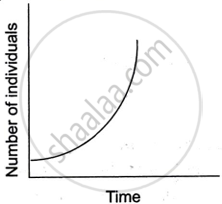 |
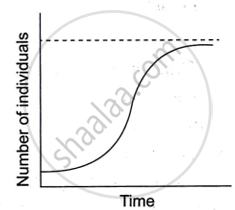 |
| Figure A | Figure B |
- Which one of the two figures represents an unlimited supply of nutrients? Give a reason.
- Which figure depicts a challenge to population growth?
- Explain the term reproductive fitness.
- Give the mathematical expressions for Figure A and Figure B.
Assertion : Population of a region does not change.
Reasoning : Birth rate, death rate and migration affect the population of a region.
Assertion (A): Population of a region does not change.
Reasoning (R): Birth rate, death rate and migration affect the population of a region.
